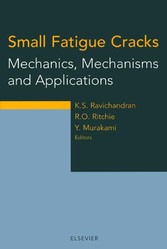Search and Find
Service
More of the content

Small Fatigue Cracks: Mechanics, Mechanisms and Applications - Mechanics, Mechanisms and Applications
A Theory of Fracture with a Polygonal Shape Crack
T. Mura Department of Civil Engineering, Northwestern University, Evanston, IL 60208, USA
ABSTRACT
The Griffith fracture theory with the use of Gibbs free energy is applied to a polygonal shape crack. It is shown that the m-pointed polygonal shape crack is easier to be initiated than an ellipsoidal crack when m is an odd number. The distinguished results obtained by Mura [1997] that a m-pointed polygonal inclusion subjected to an uniform eigenstrain has a uniform stress field inside the inclusion is obtained by another way in this paper. Pentagonal star shape inclusion Ω is a special case m= 5 and shown in Figures 1.a and 1.b.
KEYWORDS
polygonal shape crack
free energy
inclusion
eigenstrain
numerical technique
THE EQUIVALENT INCLUSION METHOD
An applied stress σij0 is distributed by σij due to the existence of the inhomogeneity Ω. This stress disturbance σij can be equivalent to the eigenstress σij in Ω. when proper eigenstrain ∈ ij* is chosen, which is determined from the following expression (see Fig. 2)
ij0+σij=Cijkl*∈kl0+∈kl=Cijkl∈kl0+∈kl−∈kl*
(1)
where
kl=Sklmn∈mn*
(2)
In Fig. 2, when Cijkl* = 0, the inhomogeneity Ω is a void or a crack.
ELASTIC FIELD OF A POLYGONALSTAR SHAPED INCLUSION
The displacement ui(x) in a inclusions Ω subject to uniform eigenstrain ∈. * ij(x ') is given in Mura [1987]
ix=Cjlmn∈mn*∫ΩGij,lx′−xdx′=Cilmn∈mn*∫ΩGij,lx−x′dx′
(3)
where Gij (x′ – x) is Green’s function for isotropic materials,
ilmn∂∂xiGijx¯=18π1−ν1−2νΔmjx¯n+Δjnx¯m−Δmnx¯jr3+3x¯nx¯mx¯jr5
(4)
Where ¯j=xj′−x¯j,r:=|x′−x|, and ¯i=rℓi where ℓ is the unit vector on ∑ as shown in Fig. 3 The locations of points x and x′ are also illustrated in Fig. 3.
When x is located inside the inclusion the integral (3) can be explicitly performed. The volume element dx′ in (3) can be written as (see Fig. 3):
x′=drdS=r2drdw
(5)
where dw is a surface element of a unit sphere ∑ centered at point x (Eshelby [1957]). Since multiplying r2 to the Eq. (4) is independent of r, integrating of (3) with respect to r, we have
ix=∈jk*8π1−ν∫∑rℓgijkℓdw
(6)
where
ijkℓ=1−2νΔijℓk+Δikℓj−Δjkℓi+3ℓiℓjℓk
(7)
and the vector ℓ is defined as
:=x′−xx′−x
(8)
An arbitrary point x′ on an m-pointed polygonal inclusion can be expressed by the following polar coordinate expression
1′=r′ϕcosϕsinθ
(9)
2′=r′ϕsinϕsinθ
(10)
3′=ccosθ
(11)
′ϕ=r0′+r1′2+4r1′−r0′π2∑n=1∞sinmπ2n2sinmnϕ
(12)
where 0 ≤ ϕ ≤ 2π,0 ≤ θ < π, n are odd integers, and r′(ϕ) = ((x′1)2+(x′2)2) 1/2 at θ = π/2. The periphery of the two-dimensional inclusion projected into x′1–x′2 plane (See Figure 3-5). r′ can be expressed by a periodic function of ϕ which is measured from the coordinate axis O′X′1. The coordinate system is so taken, such that X′1 axis passes through the point of r′0. As a periodic function of ϕ, r′ is plotted in Fig. 6. The period of an m-pointed polygonal star is 2π/m as shown in Fig. 5, in which a special case of m = 5 is plotted. Also, r′ is an even function of ϕ as shown in Fig. 6, where the shortest radius r′ is denoted by r′ 0 and the longest radius r′ by r′1. r′(ϕ) in (9)-(12) can be expressed as the Fourier series as shown follows,
′ϕ=a02+∑n=1∞ancosnπϕL+bnsinnπϕL
(13)
where
0=1L∫−LLr′ϕdϕ
(14)
n=1L∫−LLr′ϕcosnπϕLdϕ
(15)
n=1L∫−LLr′ϕsinnπϕLdϕ
(16)
where 2 L is the period of the periodic function r′(ϕ) in Fig. 6, and
:=πm
(17)
radius variation r′(ϕ) is a piecewise linear function in the interval of one period, which is
′ϕ=r0′−r1′−r0′Lϕ∀−L≤ϕ<0r0′+r1′−r0′Lϕ∀0≤ϕ (18) Then, one can show that 0=mπ∫−L0r0′−r1′−r0′Lϕdϕ+mπ∫0Lr0′+r1′−r0′Lϕdϕ=r0′+r1′ (19) n=mπ∫−L0r0′−r1′−r0′Lϕcosnmϕdϕ+mπ∫0Lr0′+r1′−r0′Lϕcosnmϕdϕ=−4r1′−r0′n2π2 (20) and n=mπ∫−L0r0′−r1′−r0′Lϕsinnmϕdϕ+mπ∫0Lr0′+r1′−r0′Lϕsinnmϕdϕ=0 (21) consequently ′ϕ=r0′+r1′2−4r1′−r0′π2∑n=1∞1n2cosnmϕ (22) or ′ϕ=r0′+r1′2−4r1′−r0′π2∑n=1∞1n2cosnmϕ−π2n+π2n=r0′+r1′2−4r1′−r0′π2.∑n=1∞1n2cosnmϕ−π2ncosmπ2−sinnmϕ−π2nsinmπ2 (23) If we denote −π2n again as ϕ, by considering the fact that cos(mπ/2) = 0 because m is odd, Eq. (23) can be written...
All prices incl. VAT













